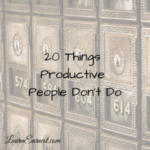Our 30 day challenge this month is to rise early. But rising before the dawn doesn’t net you anything if you don’t put that uninterrupted time to use. And even if you aren’t doing the challenge, you can still craft a productive morning routine that helps set the tone for the day.
I’ve worked on and off with early rising and morning routines for years. But as a night owl, it is hard for me to function in the morning. Even as I write this, I am fighting the impulse to go back to bed and get another hour’s sleep. But I know that if I do cave, I will miss the satisfaction of getting important things done before I face the rest of my day. So here’s how you can craft a meaningful morning routine.
SAVERS
The most well-known of the morning routines can be summed up by the acronym SAVERS. This comes from Hal Elrod’s book The Miracle Morning*. It is simply this:
- S – Silence. Meditation or reflection
- A – Affirmation. Positive affirmations for your day.
- V – Visualization. Visualizing best outcomes for what you want.
- E – Exercise.
- R – Reading. Reading something to stretch you.
- S – Scribing. Writing or journaling.
It’s a great place to start if you’re looking to build your own routine. I followed this for probably six months during my time when I was working and going to school for my teaching license. (But then life, in the form of having to leave for work at 6:30 interfered. Did I mention I’m a night owl?)
The Problem With Other’s Routine
The main problem with using someone else’s routine is simply that it’s not your own. I can look at SAVERS and agree that all those things are good. However, they’re not the most important things for me.
The danger of using someone else’s list is that it just becomes another set of things to check off a list. This can lead to quickly doing these things and receiving very little benefit. After all, these things are someone else’s task list – and we all know, through our experience with email, how much we engage and take meaning from other’s tasks.
The secret to building a morning routine is to make it your own.
Building Your Own
Having your own routine allows you to fill this time of relatively small interruption with activities that are important to you. What are those activities? Here are two places to start:
- What don’t you have time for? There are probably things that are on your task list that never seem to get done regularly. They’re not high priority or urgent, but they are definitely important. This might be things like reading non-fiction, engaging in spiritual activities or completing a craft project.
- What have you been wanting to do? Most of us have projects that we never get to because we don’t have time. Don’t underestimate the value of a regular period of short time – you will accomplish more than you think, and more than if you just wait for a bigger chunk of time. These might be writing a book, learning a new hobby or walking outside.
Implementing Your Routine
Once you have an idea of where to start, figure out a good order. I would also recommend adding time goals to these items. For instance, it wasn’t enough for me to just read non-fiction. I now read for 15 minutes — and I use a timer. This keeps me from short-changing the activity, so I get benefit from it, as well as not watching the clock.
You may not do everything on your list – start small, and you can grow it from there.
Tips for Implementing a Morning Routine
- Adjust your bedtime. Don’t think you can go to bed at the same time and get up earlier without consequences. #commonsense
- Minimize interruptions. Pick a spot and/or time you won’t be interrupted. I keep to my writing studio for most of my routines, since it is apart from the bustle of morning activities.
- Segment if necessary. You don’t have to do your morning routine all at once. I do my writing and reading first, then go downstairs to have some time with my daughter before she leaves for school and to eat breakfast. Then I go back up to my studio to do the rest.
- Review regularly. Check to make sure your morning routine meets your goals regularly. If something is not working it will be apparent – it will feel like another thing you have to check off rather than a pleasant activity.
- Have an evening routine. A good before-bed routine can support your morning routine. Things like setting up coffee so it’s ready when you wake, making sure your current book is in your morning routine spot, and setting up lunches and breakfast, can all minimize interruptions.
Conclusion
A morning routine can be productive as long as it is your morning routine. Taking time to craft one that is meaningful to you, and then putting it in place can allow you to start your day well.
If you would like a copy of the morning menu of suggestions, please fill in the form below.






